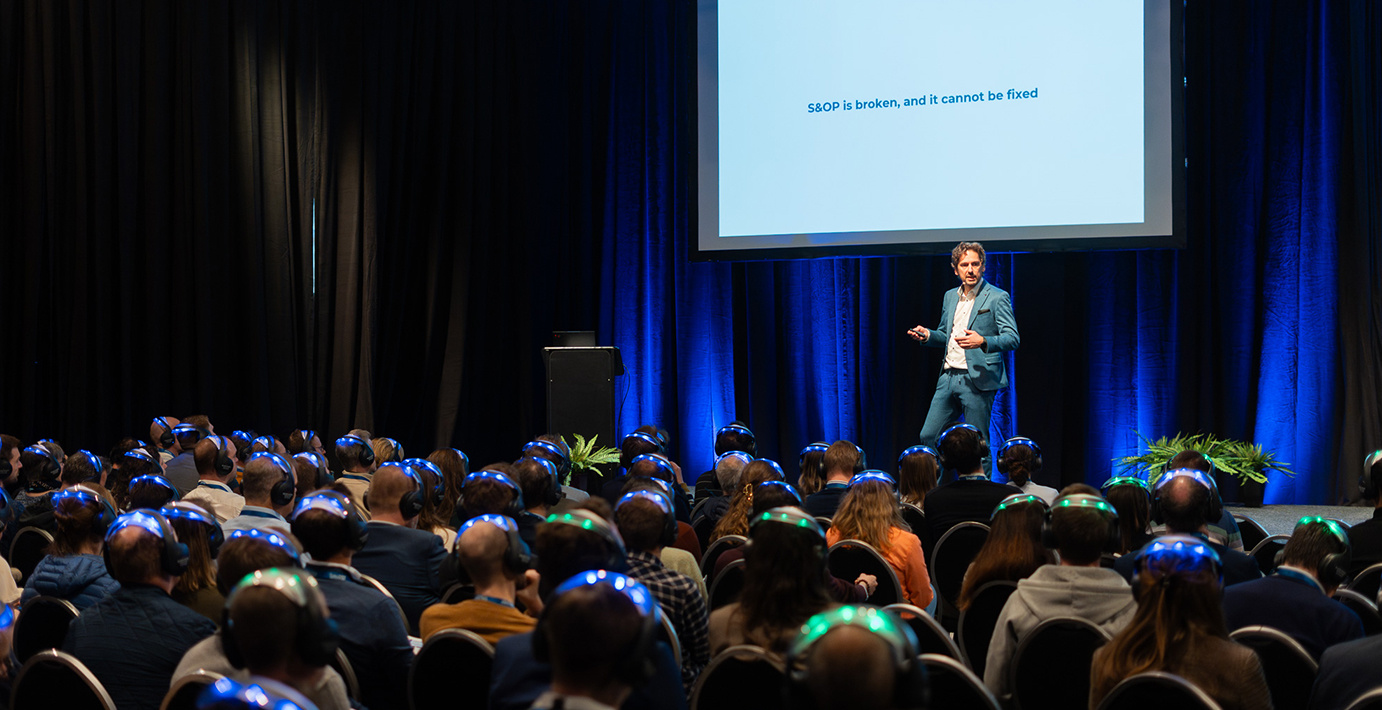
On March 20, 2025, Solventure joined the Supply Chain Innovations (SCI) event at Antwerp Expo for an insightful program of seminars on inspiring topics in Supply Chain Management. During the morning sessions, our CEO Bram Desmet gave an inspiring keynote speech on S&OP 2.0, and our customers Destrooper, Aliaxis and Bekaert presented thought-inspiring cases on how they are tackling their S&OP challenges.
“After 30 years, it’s clear S&OP isn’t delivering.” Bram Desmet got straight to the point when he went on stage for his keynote presentation on a much needed evolution from S&OP 1.0 to a new and improved version he calls Integrated Value Planning (or S&OP 2.0). “The go-to framework for planning is flawed”, he went on, “as we nowadays fail to secure buy-in, produce biased forecasts, and often collapse under unnecessary consensus.”
According to Bram, these are exactly the reasons why we need to reimagine our S&OP approach to natively integrate financial and supply chain planning. “I no longer believe in consensus demand and the continuous arm-wrestling between Sales and Supply Chain. There needs to be a smarter way to deal with this.” Instead of stifling creativity through forced consensus, Bram’s idea of S&OP 2.0 leverages the diverse perspectives of Sales, Supply Chain, and Finance to drive better scenario planning and resource allocation.
“Because if we don’t acknowledge the different risk appetites of these different stakeholders, we’ll never get everyone on board to make S&OP into an actual business planning process.” This drive for engagement from other forecasting stakeholders (primarily Finance and Sales) is the same reason why Bram also wants us to stop chasing Forecast Value Add. “Instead of trying to control Sales, it’s time to start enabling Sales and value Sales opportunities as high as inventory risks.”

One possible exercise he proposed was to consider different standardized scenarios to compare the pros and cons of each and drive the debate between all the supply chain stakeholders. “Instead of going for a consensus at the beginning of the forecasting process, we need to go for a collegial decision at the end of it!”
At the end of his keynote, Bram took some time to address his future vision for S&OP 2.0, or Integrated Value Planning:
“The starting point is a true and native integration of financial planning and supply chain planning”, as Bram also mentions in his second book. “Up to 80% of these planning processes already overlap, and – even though Finance and Supply Chain may not like it – it’s a necessary step with the current volatility on both the demand and supply side of the supply chain. It's basically irresponsible to not have proper financial information in supply chain planning, or have proper supply chain information in financial planning.”
“Once we have integrated those two we need to think through how we will connect marketing planning, sales planning, product planning and resource planning. The key thing here will be to share long-term planning data, and keep everyone aligned. Then we will need to connect with key customers and key suppliers to create a collaborative forecasting process. And when we have that connectedness, we need to think through how we include sustainability and social metrics in our core decision-making of our planning processes.”
You can read more on Bram’s view on Integrated Value Planning in his third book, ‘Rethinking Supply Chain’.

During the event, three inspiring customers of Solventure went on stage to give the audience a look behind the scenes of their recent evolution to a more effective and integrated S&OP.
Hendrik De Cock, Operations Director at Jules Destrooper, first discussed how his company handled the challenge of cost allocation by creating more clarity in their supply chain. Especially with the current market volatility (e.g. recent hikes in butter or chocolate prices) managing a diverse product portfolio such as Destrooper’s comes with hidden complexities. In his presentation Hendrik shared how they uncovered critical cost allocation gaps, gained true profitability insights, and transformed their decision-making process.
In the next customer case session, Javier Reinoso from Aliaxis shed a light on their selection process for the right planning software. Selecting a new planning software can be a game-changer for most companies looking to upgrade their S&OP, but only if you get the process right. In this presentation, Xavier shared firsthand insights on identifying pain points, setting clear selection criteria, and running an efficient vendor evaluation.
Finally, Joris Blondé, Global IT Head Supply Chain at Bekaert, gave the audience a taste of how Bekaert is transforming its supply chain at scale. During his session, Joris discussed how Bekaert is improving its tools and processes for supply chain across two business units, spanning 34 plants in total. He also addressed how an agile, MVP-driven approach is accelerating Bekaert’s progress, why traditional supply chains must evolve into dynamic eco-networks, and what key lessons the company has uncovered along the way.
As supply chains become more complex, balancing service, cost, and cash is no longer enough. Businesses must now address sustainability goals like CO2 reduction and ethical sourcing.
In a volatile world, our CEO’s S&OP 2.0 (Integrated Value Planning) embeds agility and sustainability into supply chain planning, transforming traditional processes to meet modern challenges.
The following articles may also be of interest to you:
These Stories on Strategy